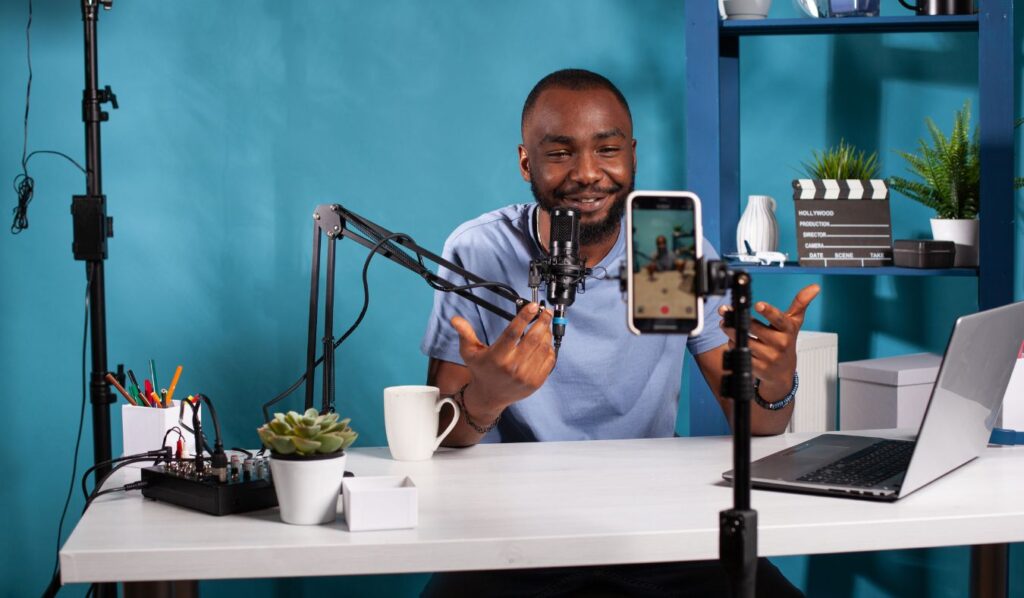Does this sound familiar? You see everyone else doing a viral TikTok dance, so you try it (even though it’s totally unrelated to your business). You hear Instagram is the place to be, so you post a few random photos with no clear captions. You boost a Facebook post because someone told you ads are a must… but you’re not really sure what you’re hoping to achieve.
This, my friends, is what we call the “Random Acts of Marketing” approach. It might feel like you’re doing something, but in reality, it’s likely leading to discouragement, mediocre results, and a whole lot of wasted time and money.
The Power of Strategy: Imagine instead, having a crystal-clear roadmap. You know exactly what types of content to create, which channels to focus your energy on, and how even a small budget can be spent wisely. That’s the power of a digital marketing strategy. Think of it like this:
Laser Focus: Strategy helps you stop chasing every shiny new trend and instead invest your resources where they’ll have the biggest impact.
Maximize ROI (Return on Investment): When your efforts are aligned with your business goals, you’re more likely to see a positive return, whether that’s in leads, sales, or brand awareness.
Agility is Key: The digital landscape changes fast. A solid strategy lets you pivot quickly without feeling like you’re starting from scratch each time the algorithm changes.
Who This is For : Whether you’re a total beginner feeling overwhelmed by the sheer volume of options in digital marketing, or a seasoned business owner realizing your ad-hoc approach isn’t cutting it anymore, this guide is for you. Strategy isn’t just for huge corporations with massive marketing teams – it’s perhaps even MORE important for smaller businesses to use their resources wisely.
Let’s get started!
1. Start with the Foundations
If you’ve ever tried to build a house on quicksand, you know it doesn’t end well. The same applies to digital marketing. Without solid groundwork, even the most sophisticated strategy is likely to crumble. So, let’s do a quick checkup on those essentials:
a) Revisit Your Why
Goals, Goals, Goals: What are you really hoping to achieve with digital marketing? More website traffic is nice, but getting specific (increase sales of [product] by 20% by Q4, etc.) gives your strategy direction.
- Know Your Audience: Who are your ideal customers? Stop trying to market to everyone and get laser-focused on the people who truly need what you offer.
- Brand Clarity: What makes your business unique? Your voice, values, and overall personality should shine through all your marketing, building recognition and trust over time.
b) It’s Not One Size Fits All
It’s tempting to look at what huge, successful companies are doing and try to replicate it. But here’s the thing: their audience, budget, and goals are likely vastly different from yours.
Your Strategy, Your Way: The best digital marketing strategy is tailored to your unique business. Blindly copying others is a path to mediocrity.
Play to Your Strengths: Are you a whiz at creating video content? Is your email list already thriving? Your strategy should leverage what you’re already doing well.
c) Define Your Scope
Trying to be everywhere at once is a recipe for burnout. Especially for smaller teams or those new to digital marketing, it’s far better to start focused.
- Start with 2-3 Channels: Where does your audience hang out? Which platforms align with your content style? Master those first.
- Room to Grow: A good strategy is scalable. As you get results and gather data, you can expand your reach thoughtfully.
2. Choose Your Channels Wisely
You could create the world’s most amazing content, but if it’s not reaching your target audience in the places they hang out online, it’s basically shouting into the void. This section is about being intentional about where you put your energy.
a) Audience-First Approach
- Do Your Research: Where are your ideal customers already spending their time? Are they scrolling Instagram, searching specific terms on Google, or joining niche Facebook groups?
- Data is Your Friend: Tools like social media analytics, audience surveys, and even checking out your competitors can reveal where your target market congregates.
- Align with Your Goals: Want to drive website traffic? SEO and content marketing will be key. Focused on building community? Certain social platforms might be the perfect fit.
b) Don’t Spread Yourself Too Thin
The temptation to be present on every single social media platform is real! But unless you have a large team, this usually leads to half-hearted efforts and inconsistent posting. Here’s why focus matters:
- Master Over Mediocrity: It’s better to be truly excellent on two platforms than posting sporadic, generic content across five.
- Quality Content Takes Time: Really understanding a platform, what resonates with its audience, and the nuances of its algorithm isn’t a “set it and forget it” task.
- Avoid Burnout: Focus brings consistency, which is vital for building an audience.
c) Mix of Channels for Maximum Impact
Even once you’ve chosen your primary focus, a well-rounded strategy often uses a combination of channels. Think of them working together:
- SEO: Helps people find you organically when they’re searching for solutions you provide.
- Social Media: Great for building relationships, showcasing your brand personality, and nurturing leads.
- Email Marketing: Lets you communicate directly with people who have already expressed interest in your business.
- Others to Consider: Content marketing, paid advertising, influencer partnerships… these can all be layered into your strategy as your needs grow.
3. Content is the Fuel
If your channels are the vehicles that get you places, content is the high-octane fuel that powers them. Great content is what attracts an audience, builds your reputation, and ultimately gets people to take the actions you want (buying, signing up, etc.)
a) The Content Pillars
Not all content is created equal. Here’s the question to guide your choices: What types of content will both resonate with your ideal audience AND support your business goals?
- Blogs: Great for SEO, establishing thought leadership, and answering those questions your customers are searching for online.
- Videos: Powerful for social media, tutorials, or product demos. Can be long-form or bite-sized (think TikTok or Reels).
- Infographics: Simplify complex data into an eye-catching format easily shareable online.
- Podcasts: Tap into the growing audio market, ideal for in-depth conversations on niche topics.
- Webinars, Guides, etc.: Offering in-depth knowledge solidifies your expert status and can be used as lead magnets.
b) Consistency is Key
Sporadic bursts of content creation followed by weeks of silence will confuse both your audience and the algorithms.
- Content Calendar to the Rescue: A simple calendar (spreadsheet, project tool, whatever works for you!) keeps you accountable and allows for advanced planning.
- Batching Your Work: Can you film several videos in one day, or draft a bunch of social posts at a time? This saves mental energy in the long run.
- Repurpose Smartly: That blog post can become 10 social posts, a video script, etc. Be efficient!
c) Think Beyond Promotion
- The Value First Mindset: If everything you post is a hard sell for your product/service, people will tune out fast.
- How Can You Help?: Solve your audience’s pain points, educate them, entertain them… this builds trust far more effectively than only pushing your offerings.
- Long-Term Play: Valuable content is why people subscribe to your email list, follow you on social… that’s when they become paying customers down the road.
4. Set Your Budget and Allocate Resources
The best strategy in the world will fail if you don’t have the budget or the people-power to execute it. This section helps you make smart decisions about where to put both your money and your time.
a) Realistic Expectations
Let’s be honest: digital marketing can take an investment to see significant results. Whether that’s an investment of time, money, or usually a combination of both, is important to understand upfront.
- The “Free” Myth: While organic tactics exist, assuming you can build a huge following with zero budget is naive. Even your “time” has value!
- Expect an Experimentation Phase: Especially early on, it’s about testing what works. Some of your budget needs to be allocated with this mindset.
- Long Game vs. Quick Fixes: Sustainable digital marketing success rarely happens overnight. Set your expectations accordingly
b) Paid vs. Organic
Both have their place in a well-rounded strategy. Let’s break it down:
- Organic: Content marketing, SEO, community building… These are largely driven by your time investment, with minimal ad spend. Results are typically slower, but more sustainable long-term.
- Paid: Social ads, PPC campaigns, etc. These can get you in front of your target audience quickly, but costs can add up if not managed carefully.
- Hybrid is Best: Often, a combination is most effective. For instance, boosting an already high-performing blog post to widen its reach.
c) Outsourcing Considerations
Not everyone can be an expert in everything. Knowing when to bring in outside help is a strategic decision in itself!
- Fill the Skill Gaps: Are you a writer, but clueless about ad targeting? That’s a potential outsourcing area.
- Time vs. Money Tradeoff: Could you DIY it with enough learning, or does it make financial sense to hire out and keep your focus on revenue-generating tasks?
- Start with Targeted Projects: Not sure about a full-time agency? Try hiring a freelancer for a specific campaign or website redesign.
Important Note: Always vet anyone you hire! Look for proven results in your niche, not just the cheapest option.
5. Measurement and Iteration
The beauty of digital marketing is that nearly everything is trackable. But drowning in data won’t help you. This section is about focusing on what truly matters and using insights to refine your strategy over time.
a) Tracking Success: What Metrics Matter Most to Your Business?
- Tie it Back to Goals: If your goal was to increase blog traffic, website visitor count is key. If it was lead generation, you’re looking at form submissions, newsletter signups, etc.
- Avoid Vanity Metrics: Sure, lots of likes feel good, but do they translate into business results?
- KPIs are Your Compass: Pick a few Key Performance Indicators to track regularly, depending on your strategy’s focus.
b) Tools to Simplify
Data without analysis is useless. Luckily, tools exist to help!
- Google Analytics: A must-have for website insights. Start with the basics (traffic sources, top pages), and go deeper as you learn.
- Social Dashboards: Built into most platforms, showing engagement, reach, etc. Again, focus on metrics aligned with goals.
- Email Analytics: Open rates, clicks, conversion rates from emails… most email marketing providers offer reporting.
- Don’t Be Afraid to Ask for Help: Analytics can be overwhelming. There are freelancers and agencies specializing in data analysis,
c) Strategy is Fluid
The digital landscape changes, your business evolves, and what worked like gangbusters one month might fizzle the next. Embrace the iterative process!
- Regular Data Review: Schedule time (weekly, monthly – depends on your pace) to look at your data and ask “why” things are happening.
- Test, Tweak, Repeat: Did a new type of social content resonate? Double down! Ad campaign flopping hard? Time for a change.
- Celebrate Wins: Data also highlights what’s working well. Understanding WHY helps you replicate those successes.
Ready to ditch the random acts of marketing and create a digital strategy that actually gets results?
Here’s your challenge:
- Pick ONE Action: Don’t try to overhaul everything at once! Maybe it’s finally defining your ideal customer, auditing your existing content, OR choosing a single channel to master.
- Share and Get Support: Let us know what you’re focusing on in the comments below. Sometimes just stating your goal out loud makes it feel more real, and you might get helpful tips from others along the way!
- Need a Roadmap? If the whole strategy thing still feels daunting, We are here to help. Book a free consultation wit us to create a plan that’s customized to your unique business needs.



